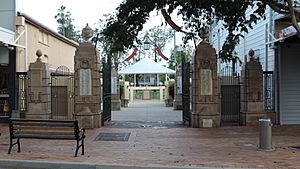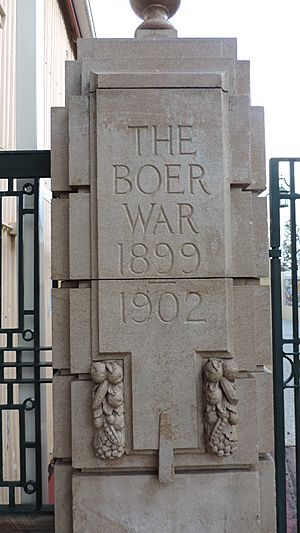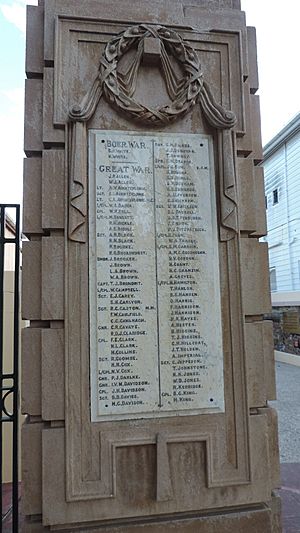Gympie and Widgee War Memorial Gates facts for kids
Quick facts for kids Gympie and Widgee War Memorial Gates |
|
|---|---|

Gympie and Widgee War Memorial Gates, 2015
|
|
| Location | Mary Street, Gympie, Gympie Region, Queensland, Australia |
| Design period | 1919–1930s (interwar period) |
| Built | 1920 |
| Architect | George Rae |
| Official name: Gympie and Widgee War Memorial Gates | |
| Type | state heritage (built) |
| Designated | 21 October 1992 |
| Reference no. | 600535 |
| Significant period | 1920– (social) 1920 (historical, fabric) |
| Significant components | memorial – park, memorial – gate/s |
| Builders | A L Petrie & Son |
| Lua error in Module:Location_map at line 420: attempt to index field 'wikibase' (a nil value). | |
The Gympie and Widgee War Memorial Gates are a special heritage-listed memorial in Gympie, Queensland, Australia. These gates stand on Mary Street, which is the main street in Gympie. They form an entrance to the Gympie Memorial Park on Reef Street.
The gates were designed by an architect named George Rae. They were built in 1920 by a company called A L Petrie & Son. These gates are an important part of Queensland's history. They were added to the Queensland Heritage Register in 1992.
Contents
A Special Memorial for Soldiers
The Gympie War Memorial Gates were officially opened in 1920. A very important person, Edward, Prince of Wales, unveiled them. The gates were designed by George Rae from Brisbane. The stone parts were made by A L Petrie and Son. A local blacksmith made the iron parts.
This memorial honors 167 local men who died in the First World War. It also remembers two men who died in the Boer War. The gates were unveiled on August 3, 1920.
How Gympie Grew
The town of Gympie started in 1867. This was after James Nash found gold there. It was the first big gold rush in Queensland. The town grew quickly to support all the gold prospectors.
The Design Competition
In 1919, the Queensland Institute of Architects held a competition. They wanted designs for a memorial in Gympie. This was for the Gympie and Widgee District Soldiers' Memorial Fund. George Rae won the competition. He was a young draftsman working in Brisbane at the time. He also won the competition to design the Toowong War Memorial in Brisbane.
George Rae was born in Scotland. He came to Brisbane in 1914. He became a registered architect in Queensland in 1929. The company, A L Petrie and Son, was the biggest stone masonry firm in Queensland. They built many First World War memorials across the state.
The Land for the Memorial
The Henderson family owned a saw mill. They gave their land for the Gympie Memorial Park. More land was bought later. Some people worried that the park was not on Mary Street, the main street. It was on Reef Street, which was behind Mary Street.
So, the Hendersons also gave a piece of land. This land was 31 feet wide. It went from Mary Street all the way to Reef Street. This created a path to the memorial park. The memorial gates stand on Mary Street at the start of this path.
The gates cost about 800 Australian pounds. The memorial was for the whole Widgee Shire. But most of the money came from public donations. The Gympie City Council also helped.
Why War Memorials Are Important
Before the First World War, Australia did not have many public monuments. The memorials built after this war became our first national monuments. They showed how much the war affected the young country. Australia lost 60,000 people out of about 4 million. This was one in five of those who served. No other war has had such a big impact on Australia.
Even before the war ended, people started building memorials. They were a way to show national sadness. For those who built them, these memorials were like sacred graves. They were substitute graves for Australians whose bodies were buried in battlefields far away. The word "cenotaph" means "empty tomb." This word was often used for war memorials.
Australian war memorials are special. They do not just remember those who died. Australians were proud that their first big army was made of volunteers. These men were worthy of honor, whether they died or not. Many memorials honor everyone from a town who served, not just those who died. This shows how much the community was involved in the war.
What the Gates Look Like
The First World War Memorial Gates are on Mary Street in Gympie. They are at the entrance to a piece of land that goes from Mary Street to Reef Street. The gates are between a hotel and a shop. They form a walkway to the Gympie Memorial Park behind them. The area between the buildings is paved. There are plants along each side.
The gates have two large and two smaller sandstone pillars. There are also wrought iron swing gates. A wrought iron arch connects the pillars. This arch holds a central lantern. There is another set of smaller pillars behind the main gates. They also have an arch and a lantern.
The two inner pillars of the main gate are larger than the outer ones. But all four pillars have a similar design.
All the pillars stand on a strong base called a plinth. From this base, a shaft of banded sandstone rises. The front of each pillar sticks out a little.
The outer pillars have stone carvings of eternal flames on top. The front of these pillars has stone plaques. One plaque says "The Great War" with dates. The other says "The Boer War" with dates. The bottom of each plaque has carvings of tropical fruit.
The inner pillars are similar but larger. They have big stone urns on top, decorated with fabric-like carvings called swags. The front of these pillars has marble plaques. These plaques list the names of local "Fallen Heroes" from the Boer and First World Wars. Above each plaque are carved laurel wreaths. At the bottom of the western pillar, there is a marble plaque with a message remembering the fallen.
The green wrought iron swing gates let cars pass between the inner pillars. Smaller gates let people walk between the inner and outer pillars. The gates have simple decorations. An ornamental archway connects the two inner pillars. It has fancy scrollwork and two flat plates. One plate says "Gympie," and the other says "Widgee." A decorative lantern hangs in the middle of the arch.
Behind the main gates, there is a second set of pillars. They are similar to the main outer pillars. These pillars have marble plaques with names of local men who served in the Vietnam and Second World Wars. They are connected by a similar decorative arch. The arch has plates that say "Lest We Forget." A lantern also hangs from its center.
Why These Gates Are Heritage Listed
The Gympie and Widgee War Memorial Gates were listed on the Queensland Heritage Register in 1992. They meet several important standards.
Showing Queensland's History
War Memorials show how Queensland's history has changed. They represent a common theme in many communities. They show a time when there was a lot of Australian patriotism and nationalism, especially during and after the First World War.
A Rare Memorial
This memorial is special because it also remembers those who died in the Boer War. This is uncommon for war memorials.
Showing Key Features
The monuments are a unique record of history. They also show what was popular in design between the two World Wars. Unveiled in 1920, the Gympie Memorial shows the main features of a memorial structure. It was built to be a lasting record of a major historical event. It uses suitable materials and design elements for this purpose.
Beautiful Design
The Memorial Gates are part of the Memorial Park. They make the town look more beautiful. They are also important for their excellent workmanship and design.
Important to the Community
The Memorial Gates have a strong and ongoing connection with the community. They show the impact of a major historical event. They are also a central place for remembering that event.
Connected to Important People
They are also specially connected to Brisbane architect George Rae. They are an early example of his work. They also have a special link to the Brisbane masonry company, A L Petrie and Son.





